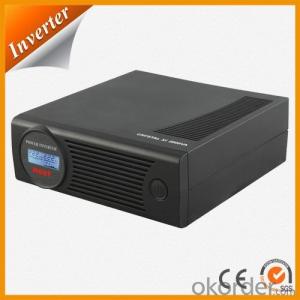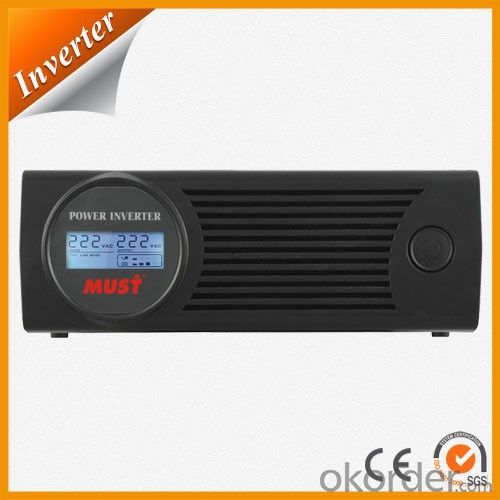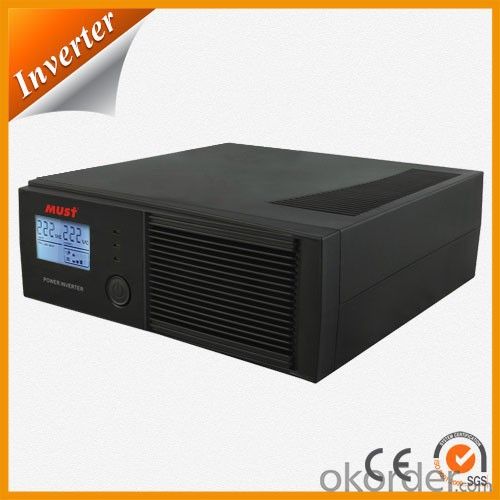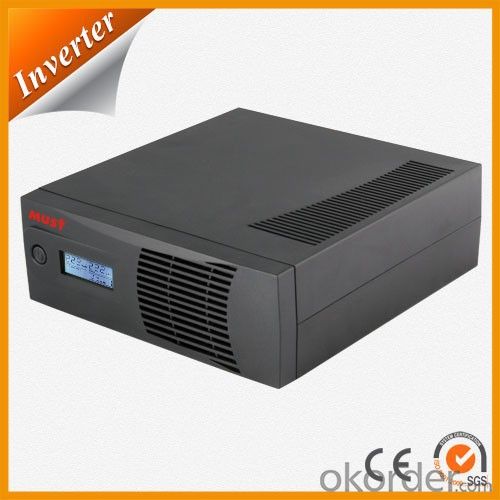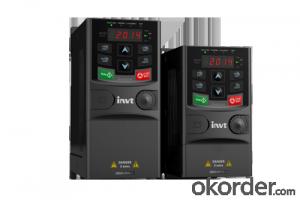Mini Solar Inverter CE Approved EP1000 with Competitive Price
- Loading Port:
- China main port
- Payment Terms:
- TT or LC
- Min Order Qty:
- 50 unit
- Supply Capability:
- 1000 unit/month
OKorder Service Pledge
OKorder Financial Service
You Might Also Like
Features:
Main for home and office Appliance such as TV,refrigerator,fan,lights,computer etc.
1.User selectable for accepting wider input voltage.
2.Rack Tower design, high Frequency, off mode charging.
3.Compact size for convenient use and storage.
4.Built-in from 8Amp super charger up to 100Ah battery.
5.Small scale and cost effective inverter for home appliances and office equipments
6.Three – steps Three – steps intelligent charging control to recharging time.
NEW Function:10A/20A charging current adjustable .
Four new panel for your reference
Front panel & Sockets
Inside Structure
Rated Capacity | 500VA/300W | 1000VA/600W | 2000VA/1200W |
Input | |||
Models | 120V Models | 230V Models | |
Nominal Voltage | 110V/115V/120V Selectable | 220V/230V/240V Selectable | |
Input Frequency | 47Hz ~ 65Hz, 50/60Hz Auto-Sensing | ||
Efficiency | 95%(Normal Mode) | ||
Noise Filtering | Full Time EMI/RFI Filtering | ||
Over Current Protection | By Re-Settable Over Current Protector | ||
Voltage Range | 90 - 145VAC Or 170-280VAC ( Narrow Range ) | ||
Surge Protection | 324 Joules | ||
Output | |||
Rated Power | 500va/300w | 1000VA/600W | 2000VA/12000W |
Output Voltage | 100V/110V/115V/120V Selectable | 220V/230V/240v selectable | |
Voltage Waveform | Modified Sine Wave | ||
Crest Factor | 3:01 | ||
Output Frequency (Synchronized-Mains) | Auto Select For 50/60Hz 47Hz ~ 55Hz For 50Hz Nominal; 56Hz ~ 65Hz For 60Hz Nominal | ||
Regulation(Battery Mode) | 10% -18% | ||
Transfer Time | 15ms Typical 50ms Max | ||
Protection | Over Load, Discharge, Overcharged | ||
Battery Type | Lead-Acid 12V 25Ah ~ 250Ah | ||
Voltage | 500VA/1000VA :DC12V ; 2000VA :DC24V | ||
Backup Time | Depend On Battery | ||
Charging Method | 3 Steps Super Charge Mode | ||
Charging Current | 10A-20A Adjustable Charge Current | ||
Protection | Over Current Protection Over Charging Voltage Protection (No More Than 15V) Deep Discharge, Overload Protection | ||
Communications & Management | |||
Control Panel(LCD Indicator) | Input & Output Voltage, Battery Capacity, | ||
Audible Alarm | Low Battery | Sounding Every 2 Seconds | |
Overload | Sounding Every 0.5 Second | ||
Fault | Continuously Sounding | ||
Environment And Safety | |||
Operating Environment | 0~40 Degrees Centigrade, 0 - 90% Non Condensing | ||
Transit/Storage | -15℃ To 55℃ (5℉ To 131℉) D39 | ||
Operating Altitude | 0 ~ 3000 Meters | ||
Audible Noise | ≦50dba | ||
Safety Markings | CE.FCC | ||
Quality Control System | ISO 9001 | ||
Physical | |||
Dimensions (H×D×W) | 355*130*230mm | ||
N.W/G.W(Kg) | 1.6/2 (Kg) | 2/2.3 (Kg) | 2.2/2.6 (Kg) |
Packing | 6pcs/Carton | ||
Warranty
provides a 1~3 year limited warranty (“Warranty”) against defects in materials and workmanship for its Uninterruptible power supply, Power inverter/chargers, Solar charge controllers, Battery Products (“Product”).
The term of this Warranty begins on the Product(s) initial purchase date, or the date of receipt of the Product(s) by the end user, whichever is later. This must be indicated on the invoice, bill of sale, and/or warranty registration card submitted to MUST-Solar. This Warranty applies to the original MUST-Solar Product purchaser, and is transferable only if the Product remains installed in the original use location.
FAQ
1. How do I decide which system is right for me ?
For protection from long outages, include a generator or solar panels in your Must solar system. Shorter outages can be handled by a battery-only system.
2. Where my system will be installed ?
Must solar systems are usually wall-mounted near a home's main electrical (circuit breaker) panel.
3. How do I install my system ?
A must solar backup inverter is connected to a home electric system , we will supply detailed installation manual and videos for our customers .
Images
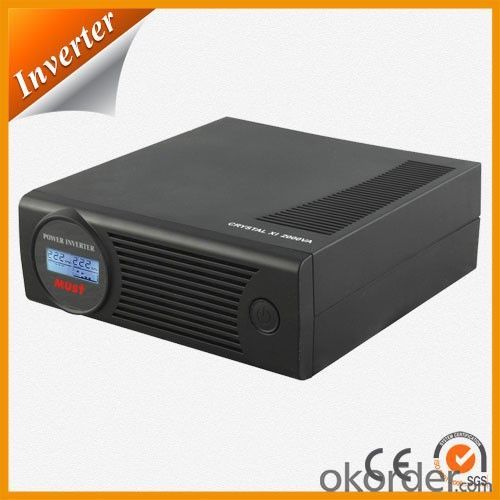
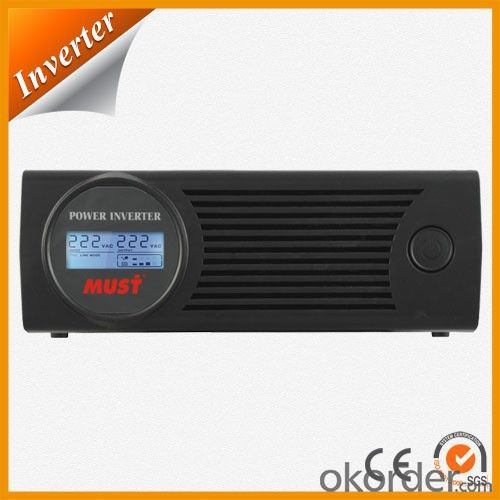
- Q: How does the input frequency range affect the performance of a solar inverter?
- The input frequency range directly affects the performance of a solar inverter. A wider input frequency range allows the inverter to efficiently convert a broader range of solar panel output frequencies into usable electricity. This flexibility ensures that the inverter can effectively handle varying solar panel output and maintain stable and reliable power conversion. Conversely, a limited input frequency range may result in poor performance, reduced efficiency, and potential instability or failure of the inverter under certain conditions.
- Q: How does the input current rating affect the performance of a solar inverter?
- The input current rating of a solar inverter directly affects its performance as it determines the maximum amount of current that can be supplied to the inverter. If the input current rating is too low, the inverter may not be able to handle the power generated by the solar panels efficiently, resulting in reduced performance. Conversely, if the input current rating is high, the inverter can handle a larger amount of power and perform optimally. Therefore, selecting an inverter with an appropriate input current rating is crucial for ensuring smooth and efficient operation of a solar power system.
- Q: What is the role of capacitors in a solar inverter?
- The role of capacitors in a solar inverter is to store and release electrical energy, helping to stabilize the voltage and provide smooth and continuous power output. Capacitors in a solar inverter also assist in filtering out any unwanted electrical noise or interference, ensuring the efficient and reliable operation of the inverter.
- Q: How does a solar inverter handle grid synchronization during startup?
- A solar inverter handles grid synchronization during startup by employing advanced control algorithms. It continuously monitors the grid voltage and frequency, aligns itself with the grid parameters, and gradually increases its output power to match the grid. This synchronization process ensures that the solar inverter seamlessly integrates with the grid and provides stable and synchronized power generation.
- Q: Can a solar inverter be used with a solar-powered remote monitoring system?
- Yes, a solar inverter can be used with a solar-powered remote monitoring system. The solar inverter converts the DC (direct current) electricity generated by the solar panels into AC (alternating current) electricity that can be used to power the remote monitoring system. This allows the system to be powered by solar energy and provides the necessary electricity for monitoring and data transmission.
- Q: What are the potential risks of overvoltage in a solar inverter?
- The potential risks of overvoltage in a solar inverter include damage to the inverter itself, as well as other connected equipment such as solar panels and batteries. It can also lead to electrical fires or pose a safety hazard to individuals working with or near the system. Additionally, overvoltage can result in a loss of energy production and potential financial losses for the system owner. Regular monitoring and proper voltage regulation are essential to mitigate these risks.
- Q: Photovoltaic grid-connected inverter problem
- Hello, the definition of the zero line is not caused by the transformer three-phase electric tail connection? I now do not understand why there is no isolation transformer AC output marked is N (zero line), and it is not the transformer three-phase power of the tail connection leads to, this is the zero line? The The
- Q: How do I monitor the performance of a solar inverter?
- To monitor the performance of a solar inverter, you can follow these steps: 1. Use a monitoring system: Many solar inverters come with built-in monitoring systems that provide real-time data on their performance. These systems often have user-friendly interfaces that allow you to easily track key metrics like energy production, voltage, and frequency. 2. Install a monitoring device: If your solar inverter doesn't have a built-in monitoring system, you can install an external monitoring device. These devices can be connected to the inverter and provide detailed performance data, which can be accessed through a dedicated software or app. 3. Track energy production: Keep a record of the energy produced by your solar inverter on a daily, weekly, or monthly basis. This will help you assess its performance over time and identify any potential issues or discrepancies. 4. Monitor key metrics: Monitor important metrics such as voltage and frequency to ensure that your solar inverter is operating within the desired parameters. Deviations from the expected values could indicate a problem that needs attention. 5. Set up alerts: Some monitoring systems or devices allow you to set up alerts for specific performance thresholds. This way, you will be notified if the inverter's performance falls below or exceeds certain limits, enabling you to take prompt action. 6. Regularly check for errors or alarms: Check the monitoring system or device for any error codes or alarms that indicate malfunctions or issues with the inverter. Addressing these problems early on can prevent further damage and optimize performance. By regularly monitoring the performance of your solar inverter, you can ensure its efficiency, detect potential problems, and maximize the energy output of your solar system.
- Q: What is the maximum efficiency of a solar inverter?
- The maximum efficiency of a solar inverter typically ranges from 95% to 98%.
- Q: Can a solar inverter be used in areas with limited roof space or installation options?
- Yes, a solar inverter can be used in areas with limited roof space or installation options. Solar inverters are flexible and can be installed in various locations such as walls, ground mounts, or even on poles, allowing for more flexibility in terms of space and installation options. Additionally, there are also compact and space-saving solar inverters available that can be used in areas with limited roof space.
Send your message to us
Mini Solar Inverter CE Approved EP1000 with Competitive Price
- Loading Port:
- China main port
- Payment Terms:
- TT or LC
- Min Order Qty:
- 50 unit
- Supply Capability:
- 1000 unit/month
OKorder Service Pledge
OKorder Financial Service
Similar products
Hot products
Hot Searches
Related keywords
